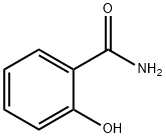Description
Salicylamide is less acidic (pKa 8.2) than other salicylic acid derivatives. Although poorly soluble in water, stable solutions can be formed at pH 9 through ionization of the phenolic group. It is absorbed from the GI tract on oral administration and is rapidly metabolized to inactive metabolites by intestinal mucosa, but not by hydrolysis. Activity appears to reside in the intact molecule. It is approximately 40 to 55% plasma protein bound, and it competes with other salicylates and acetaminophen for glucuronide conjugation, decreasing the extent of conjugation of these other drugs.
Chemical Properties
Salicylamide is a odorless white or slightly pink crystals. It is less acidic (pKa 8.2) than other salicylic acid derivatives. Although poorly soluble in water, stable solutions can be formed at pH 9 through ionization of the phenolic group.
Uses
salicylamide is an analgesic, fungicide, and anti-inflammatory ingredient used to soothe the skin. It is an aromatic amide.
Uses
Salicylamide is used in combination with both aspirin and caffeine in the over-the-counter pain remedies. It is used as an analgesic and as an antipyretic.
Definition
ChEBI: The simplest member of the class of salicylamides derived from salicylic acid.
General Description
Salicylamide, o-hydroxybenzamide, is a derivative of salicylicacid that is fairly stable to heat, light, and moisture. Itreportedly exerts a moderately quicker and deeper analgesiceffect than aspirin because of quicker CNS penetration. Its metabolismdiffers from aspirin, because it is not metabolized tosalicylic acid but rather excreted exclusively as the ether glucuronideor sulfate. Thus, as a result of lack of contributionfrom salicylic acid, it has a lower analgesic and antipyretic efficacythan that of aspirin. However, it can be used in place ofsalicylates for patients with a demonstrated sensitivity to salicylates.It is also excreted much more rapidly than other salicylates,which accounts for its lower toxicity. It is available inseveral nonprescription products, in combination with acetaminophenand phenyltoloxamine (e.g., Rid-A Pain compound,Cetazone T, Dolorex, Ed-Flex, Lobac) or with aspirin,acetaminophen, and caffeine (e.g., Saleto, BC Powder).
Air & Water Reactions
Salicylamide darkens on exposure to air. . Insoluble in water.
Reactivity Profile
Salicylamide is an amide. Amides/imides react with azo and diazo compounds to generate toxic gases. Flammable gases are formed by the reaction of organic amides/imides with strong reducing agents. Amides are very weak bases (weaker than water). Imides are less basic yet and in fact react with strong bases to form salts. That is, they can react as acids. Mixing amides with dehydrating agents such as P2O5 or SOCl2 generates the corresponding nitrile. The combustion of these compounds generates mixed oxides of nitrogen (NOx). Salicylamide may be sensitive to prolonged exposure to light.
Hazard
One of the primary side effects associated with Salicylamide is gastrointestinal discomfort. Allergic reactions are another potential side effect. It can also have effects on the liver. Prolonged use or high doses may lead to liver damage, which can present as jaundice (yellowing of the skin or eyes), dark urine, or pale stools.
Fire Hazard
Flash point data for Salicylamide are not available; however, it is probably combustible.
Clinical Use
Whereas salicylamide is reported to be as effective as aspirin as an
analgetic/antipyretic and is effective in relieving pain associated with arthritic conditions, it does not appear to
possess useful anti-inflammatory activity. Thus, indications for the treatment of arthritic disease states are
unwarranted, and its use is restricted to the relief of minor aches and pain at a dosage of 325 to 650 mg three or four
times per day. Its effects in humans are not reliable, however, and its use is not widely recommended.
Purification Methods
Crystallise the amide from water or repeatedly from CHCl3 [Nishiya et al. J Am Chem Soc 108 3880 1986]. [Beilstein 10 IV 169.] The anilide [87-17-2] M 213.2, m 135o crystallises from H2O. [Beilstein 12 H 500, 12 I 268, 12 II 256, 12 944.]




